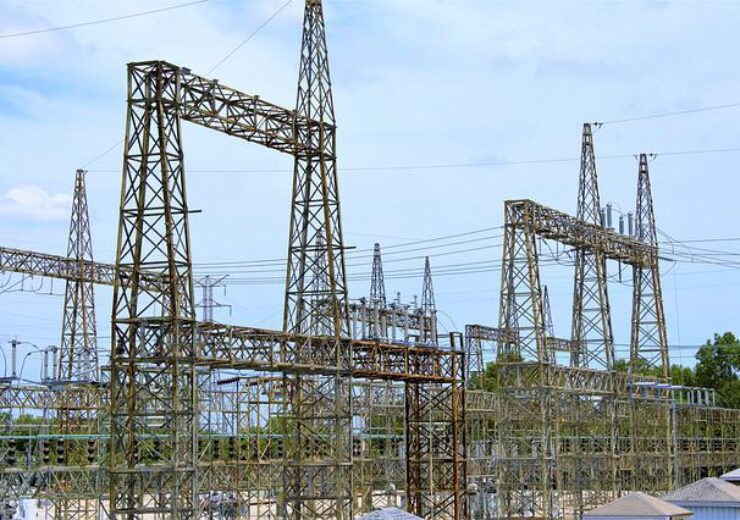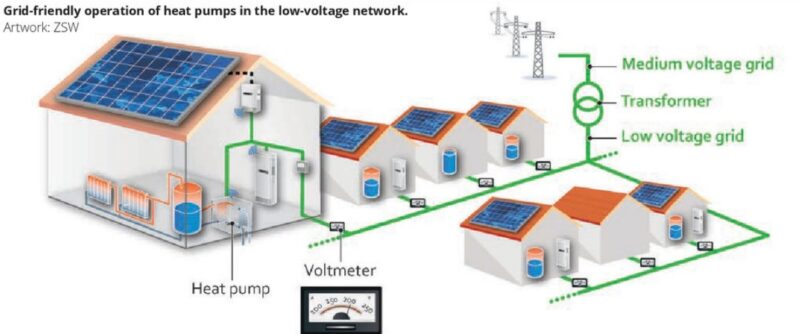Heat pumps, with their ability to provide ecofriendly heating and hot water, are crucial to the transition to climate-neutral buildings. Around 53% of new buildings erected in Germany last year were equipped with them. However, they could overburden electric power distribution networks as their numbers rise. To address this, ZSW (Centre for Solar Energy and Hydrogen Research Baden-Württemberg) has been working on algorithms to reduce peak loads and has successfully tested them in Sweden, where heat pumps see widespread use and winters are particularly frost

Credit: Scottslm from Pixabay
When it gets cold outdoors, heat pumps have to deliver a great deal of heat at the same time, especially in the morning and at night. Demand for electricity in the distribution network spikes at these times. Peak loads in the networks and transformers that convert medium-voltage to the distribution network’s low voltage then surge – perhaps even enough to cause overloads.
The concept described here is among many methods that ZSW has developed for grid operators, manufacturers and users. The overall idea is to operate heat pumps, e-charging stations, and other devices that consume a lot of power in legacy grids, in an intelligent way that does not appreciably inhibit their performance.
To this end, ZSW researchers have developed algorithms to reduce concurrent heat pump loads in a given grid area.*
“The challenge is to keep everyone’s house warm in the early morning and evening hours without all the heat pumps starting up at once – even on days when the outdoor temperature drops to minus 10°C. We developed a predictive method of operating heat pumps that draws on heat demand forecasts to accomplish this”, says the ZSW’s Dr Jann Binder.
When the forecast predicts a rising grid load, the heat pumps switch on earlier and run longer, but with lower output. The houses, with their capacity to retain heat, serves as a storage medium to lighten the load on the grid. This method is applied “judiciously to keep heat loss in check and the temperature close to the set point.”

The researchers had two options, says ZSW. One was a centralised approach, with a hub that uses virtual energy prices to incentivise household heat pumps to operate in a distributed way. The other option was a decentralised approach with no connections to a central hub. In this case, the heat pumps would respond only to locally detected temperature fluctuations and grid voltage reductions.
The centralised approach lightens the grid load by the targeted 10%. It also requires 3% less added heating energy than the decentralised approach because it provides a more precise way of precluding the need for preheating and concurrent heat pump operation.
However, it does require a lot of calculation to determine the individual schedules and more communication among all heat pumps and the hub.
The indoor temperature range did not change much – only from 20-22°C to 19.2-22.2°C – as a result of the 10% peak-time reduction in transformer loads achieved by the simpler decentralised approach. Adding in a forecast for the outdoor temperature trend raises the lowest temperature to 19.4°C. The lowest indoor temperature drops to 17°C when the same reduction in transformer load is accomplished with a linear reduction in the heat pump’s output. In other words, the temperature drops by as much as 3°C rather than merely by 0.6°C.
The ZSW was determined to keep it simple when it developed the decentralised approach. “This algorithm does not need an outside communication link to remotely control heat pumps”, says Binder. “Information is sourced from the locally metered grid voltage.” The voltage dropping below a certain threshold indicates the grid load is too high. The algorithm then kicks in to modulate the heat pump’s output. This decentralised algorithm can exploit a house’s capacity to store heat precisely and specifically to the extent necessary – without the complicated bidirectional communication needed for central heat pump management. The temperature does not drop nearly as much as it would if a central hub switches the heat pumps off in the event of a bottleneck.
Field tests in Sweden
Sweden provides excellent conditions for studying the impact of heat pumps on the power grid and for trying out grid-friendly ways of operating these pumps. Heat pumps have been adopted on a large scale thanks to the country’s high carbon tax.
ZSW researchers chose Ramsjö, a village near Stockholm, for trial runs. With houses heated mainly by heat pumps and cold winter days that place a very heavy load on transformers, it provided the perfect proving ground.
* This research initiative was part of the NEMoGrid project funded by BMWi, the German Federal Ministry for Economic Affairs and Energy (funding code 0350016A)
This article first appeared in Modern Power Systems magazine.
